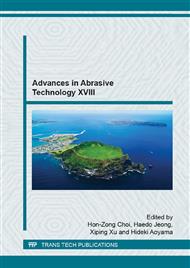p.543
p.549
p.555
p.561
p.567
p.573
p.581
p.586
p.592
Effect of Carbide Orientation on Sliding Wear Behaviour of High Chromium Cast Iron
Abstract:
The effect of carbide orientation on the dry sliding wear behaviour of high chromium cast iron was studied by pin-on-disc type wear tests at room temperature. The carbide anisotropy was achieved by thermomechanical treatments at temperatures of 950 and 1150 °C. By cladding with low carbon steel, the brittle high chromium cast iron was hot compressed severely with crack free. The thermomechanical treatments not only change the carbide orientation, but also increase the volume fraction of carbides. Due to the long axis of carbide rods is parallel to the wear surface, the high chromium cast iron treated at 1150 °C has a superior wear resistance than the as-cast one, in which the long axis of carbides is perpendicular to the wear surface. For the high chromium cast iron treated at 950 °C, high volume fraction of carbide pits accelerates the wear rate significantly even though it has a similar carbide orientation as the sample treated at 1150 °C. The observations on wear tracks reveal that the ferrous matrix can be protected better from abrasion when the high chromium cast iron was treated at 1150 °C.
Info:
Periodical:
Pages:
567-572
Citation:
Online since:
January 2016
Authors:
Price:
Сopyright:
© 2016 Trans Tech Publications Ltd. All Rights Reserved
Share:
Citation:


